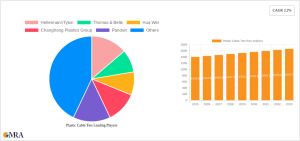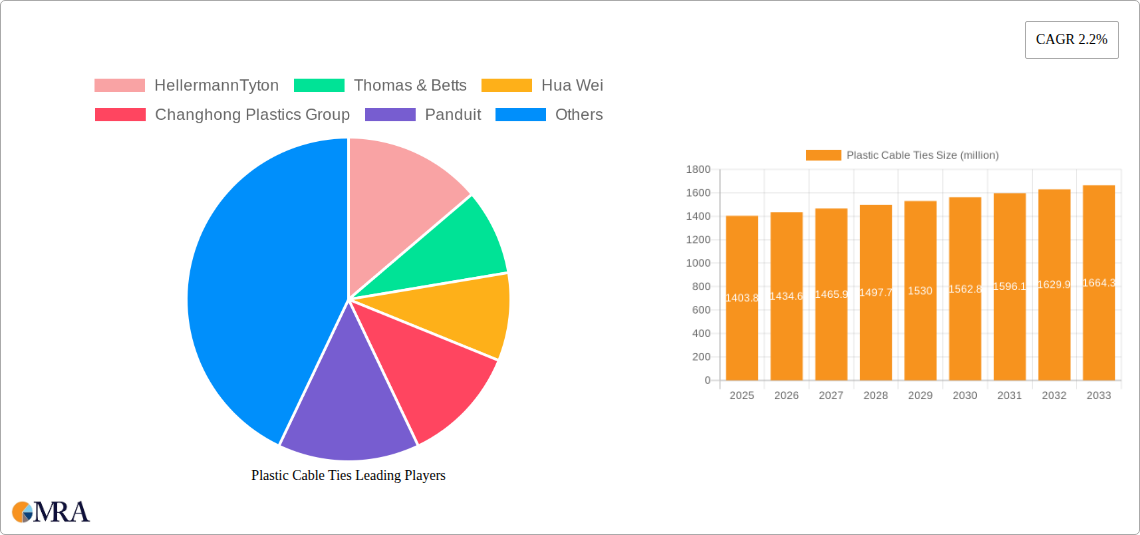lastic Cable Ties by Application (Electronic, Home Appliances, Automobile, Logistics, Others…), by Types (PA66 Cable Tie, PA6 Cable Tie, PE Cable Tie, PTFE Cable Tie), by North America (United States, Canada, Mexico), by South America (Brazil, Argentina, Rest of South America), by Europe (United Kingdom, Germany, France, Italy, Spain, Russia, Benelux, Nordics, Rest of Europe), by Middle East & Africa (Turkey, Israel, GCC, North Africa, South Africa, Rest of Middle East & Africa), by Asia Pacific (China, India, Japan, South Korea, ASEAN, Rest of Asia Pacific,…) Forecast from 2025 to 2033.
The global plastic cable ties market, valued at $1403.8 million in 2025, is projected to experience steady growth, driven primarily by the expanding electrical and electronics industry, automotive sector, and construction activities. The market’s Compound Annual Growth Rate (CAGR) of 2.2% from 2025 to 2033 reflects a consistent demand for these essential fastening solutions. Key growth drivers include the increasing adoption of automation in manufacturing, the rising demand for durable and reliable cable management systems, and the ongoing infrastructure development globally. While the market faces challenges such as fluctuating raw material prices and the emergence of alternative fastening technologies, the overall outlook remains positive.
The market segmentation, while not explicitly detailed, likely comprises various types of plastic cable ties based on material (nylon, polypropylene, etc.), size, and fastening mechanisms. Regional variations in market growth may reflect differing levels of industrialization and infrastructure development. Future growth will depend on technological advancements, the continued expansion of key end-use sectors, and strategic partnerships between manufacturers and downstream industries. The market’s relatively modest CAGR suggests a mature but stable market, benefiting from consistent demand within established sectors and the gradual expansion into new applications. A detailed analysis of regional data would provide more granular insights into specific market dynamics and opportunities.

Plastic Cable Ties Concentration & Characteristics :
The global plastic cable tie market is highly fragmented, with numerous players competing across various regions. However, a few large multinational corporations, such as HellermannTyton and Panduit, hold significant market share, estimated at over 15% combined. Concentration is higher in developed markets like North America and Europe, where larger companies benefit from established distribution networks and brand recognition. In contrast, developing economies see a higher number of smaller, regional manufacturers…
Concentration Areas:
- North America (US, Canada)
- Western Europe (Germany, France, UK)
- East Asia (China, Japan, South Korea)
Characteristics of Innovation :
- Material innovation: Focus on biodegradable and recycled plastics to address environmental concerns.
- Design improvements: Development of specialized cable ties for specific applications (high temperature, UV resistance, etc.).
- Automated fastening systems: Integration with automated assembly lines for improved efficiency.
Product Substitutes :
Alternatives like straps, zip ties made from other materials (e.g., metal), and adhesive solutions are available, but plastic cable ties maintain a dominant position due to their cost-effectiveness and versatility.
End User Concentration :
Significant end-user concentration exists in the automotive, electronics, and construction industries and all sectors account for a large portion of the total demand…


